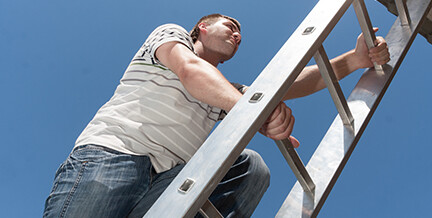
Protect Yourself
We use ladders as tools while trying to accomplish our jobs. Ladder safety usually follows the same rules that apply when using most tools:
- Choose the best equipment for the job. Instead of using ladders to work from, use scissor lifts or scaffolding – they’re safer. Try to use ladders only for climbing to other levels.
- Pick the correct ladder height.
- Maximum weight capacities on commercial ladders will be located on a sticker. Use only ladders that have weight capacities of 250 lbs. or higher.
- Ladder steps, rungs and cleats have to be level, evenly spaced, and parallel. The steps/rungs should be grooved to prevent slipping. The side rails have to be at least 11 ½” apart.
- Ladders can not be tied together.
- The use of two or more ladders to reach a spot is only safe when there is a landing or platform in between them.
- To prevent cuts, punctures, or snagging of clothing, make sure all ladder parts are smooth.
- Wood ladders should not be painted with a coating that could hide dangerous defects.
- Ladder use must be taught so that individuals may use them safely and responsibly.
Setting up a Ladder
- If possible, using two people to carry and set up a ladder is the safest option.
- Ladders and any other tools you might be using should be kept at least ten feet away from any overhead obstructions or power lines. Aluminum and even dirty or wet wood or fiberglass ladders can easily conduct electricity.
- Put the ladder on sturdy, flat ground, or for uneven surfaces, use a ladder leveler. The ladder should be secured – tied down, installed with slip resistant feet, or have someone hold the ladder during use.
- The area surrounding the ladder should be clear, and if it is in a high-traffic area the work area should be cordoned off.
- Never set a ladder on another object like scaffolding or a box.
Using a Ladder
- Before you use a ladder, always check it. If it is an older ladder that has not been used in a while, recheck it for any wear.
- When using a ladder, always face it.
- Shoes with slip-resistant soles are the safest type to use when using a ladder.
- Maintain 3-point contact with your ladder (for example, two feet and one hand).
- To not trip over your ladder, keep your body centered between the side rails.
- Never work from the top three steps of a straight or extension ladder, or from the top step of a stepladder.
- Never use a ladder if it is windy.
- If someone is on it, never move a ladder.
- Before you move it, lower the top portion of an extension ladder.
Please contact us to discuss how Boster, Kobayashi and Associates can expertly handle your case.
Share
11
JUN
2015
JUN
2015
0

